Ever answered a call, only to hear a sketchy robot offering a free vacation – or worse, pretending to be your bank? You’re not alone. The survey found that 96.8% of people have been hit with scam messages. Nearly half (49%) got them via SMS, and 26.5% through calls.
Scammers often use phone number spoofing to fake their caller ID, making it look like the call is coming from a trusted source. It could appear to be a local business, a government agency – or even your own number.
But here’s the good news: You can fight back. If you know how to tell if a phone number is spoofed, you can dodge scams before they waste your time (or your money). In this guide, we’ll show you how to uncover who’s calling and block them for good. Let’s shut these scammers down.
What Is Caller ID Spoofing?
Scammers aren’t just sketchy individuals calling from random blocked numbers anymore. These days, some of them run full-blown “businesses” – complete with customer service scripts, deepfake voices, and fake official hotlines. They’ve turned fraud into a profession, and the worst part? It’s getting harder to tell what’s real and what’s not.
Caller ID spoofing is one of their sneakiest tricks. It lets them fake a phone number to look like someone you trust – your bank, a government agency, or even a family member. They don’t just want you to answer; they want you to trust them.
Why is spoofing so dangerous? These calls aren’t just annoying. They can wreck lives. Here’s how:
- Stealing your identity – They pretend to be your bank, tricking you into handing over personal info.
- Draining your money – Fake fraud alerts convince people to “transfer” their savings for “security reasons”.
- Grabbing personal info – They fish for Social Security numbers, passwords, and home addresses.
- Tricking kids – Some scammers target kids, getting them to reveal private family details.
- Scamming elderly parents – Fake “Grandma, I’m in trouble” calls pressure seniors into wiring money fast.
So, what should you do? Simple – don’t pick up. If it’s important, they’ll leave a voicemail. If you’re unsure, learn how to tell if a phone number is spoofed before calling back. And if you’re wondering how to stop someone from spoofing my phone number, stick around.
How to Spot a Fake Call: Key Signs
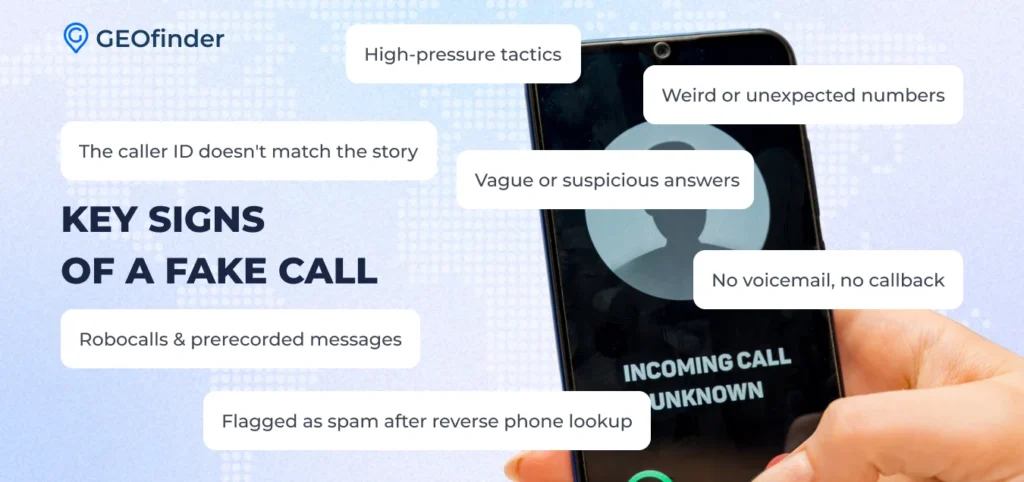
Scammers are slick, but their calls usually have tell-tale signs. If a call feels off, trust your gut. Here’s how to tell if a phone number is spoofed before you waste a second on it.
Red flags to watch for:
- Weird or unexpected numbers – Calls from strange area codes, international numbers, or numbers that look suspiciously similar to yours? Red flag.
- High-pressure tactics – If they demand you act right now – pay a bill, confirm info, or claim a prize – it’s likely a scam. Legit businesses don’t rush you.
- Vague or suspicious answers – Ask them who they are and why they’re calling. If they dodge the question or get aggressive, hang up.
- Robocalls & prerecorded messages – Banks and government agencies rarely use robotic voices for real issues.
- The caller ID doesn’t match the story – They claim to be from your bank, but the number looks random? Don’t trust it.
- No voicemail, no callback – Scammers rarely leave voicemails, and if you try calling back, the number might not even work.
- If it’s flagged as spam, you’ve got your answer – Do a reverse phone lookup online. If others have reported it, you know what to do – block it.
How to Uncover a Spoofed Number?
Got a weird call? Something about it just feels… off? Maybe the number looks local, but the voice doesn’t match. Maybe they’re rushing you to act fast. Or maybe your gut is just screaming “scam alert!” (good instinct). Here’s how to uncover a spoofed number and outsmart whoever’s on the other end.
Use GEOfinder to Dig Up the Truth

Scammers love hiding behind fake numbers, but GEOfinder.mobi can pull back the curtain. It’s a reverse phone lookup tool that can track down real details about almost any number anywhere in the world.
What it tells you:
- Full name – Who’s really calling you?
- Home address – Where are they actually based?
- Family connections – Who else are they linked to?
- Social media profiles – Are they a ghost or a real person?
- Email address – Another way to verify them.
- Location history – Where have they been?
- Web activity – Are they up to something shady?
How to use it:
- Enter the number (no downloads needed).
- Add your email.
- Grab the 1-day trial or pick a plan.
- Start snooping.
Need to see someone’s address? GEOfinder has a tracking feature that shows a caller’s location within 10 meters. If they claim to be from your bank, but their location pings from a random spot halfway across the world? That’s a huge red flag.
Dial 69 to Check Who Called Last
If you just got a sketchy call and didn’t answer, *dialing 69 can tell you the last incoming number (unless it was blocked).
How to do it:
- Hang up (or decline the call).
- Dial *69 and hit call.
- Listen to the details – you’ll usually get the number, time, and date of the call.
- Keep a record. If that number keeps popping up, you’ve got proof to report.
Dial 57 to Trace Harassing Calls
Getting threatening or creepy calls? Your phone company might be able to trace the caller with *57. This sends their info straight to law enforcement.
How to do it:
- Hang up immediately – don’t engage.
- Dial *57 and hit call.
- Write down the time, date, and anything suspicious about the call.
Heads up: Some phone carriers charge extra for this service, so check first.
Other Tricks
If you’re unsure about a suspicious call, try calling the number back from a different phone. A spoofed number often results in a “number not in service” message. You can also check online scam databases to see if others have flagged the same number, using sites like Scamwatcher. Many apps are designed to track spam calls, so use those to verify if the number has a bad reputation. These simple steps can save you time and help you avoid falling for a scam.
How Your Carrier and the Authorities Can Help You Fight Spoofed Calls
You don’t have to fight spoofers alone. Your carrier is no stranger to spam calls – they deal with them daily. While they can’t magically reveal the mystery caller every time, they can help trace a spoofed phone number, block future calls, and give you some peace of mind.
Here’s how to get the most out of your phone provider:
- Gather the info – Before you call, write down as much detail as you can. Dates, times, and any recurring numbers. The more specifics, the better.
- Ask about tracing the call – See if your provider can help you identify the caller or at least tell you where the call came from. Sometimes, they can see if the number was spoofed. This info could be useful if you need to involve law enforcement.
- Inquire about extra security features – Some providers have call-blocking options, spam filters, or even call rejection features. Ask about what’s available to you, and turn them on to reduce your chances of getting another scam call.
If things have gone beyond annoying, and the scammer has crossed into harassment or threats, you might consider reporting it to the authorities. Law enforcement has tools that can help track down these fraudsters and put a stop to it.
Who to contact:
- FCC (Federal Communications Commission) – In the U.S., the FCC handles phone fraud, and they can even fine scammers if they catch them.
- FTC (Federal Trade Commission) – If it’s a scam, you can report it at reportfraud.ftc.gov.
- Your local police – For serious cases, like threats or identity theft, file a police report.
Protecting Yourself from Spoofing Attacks
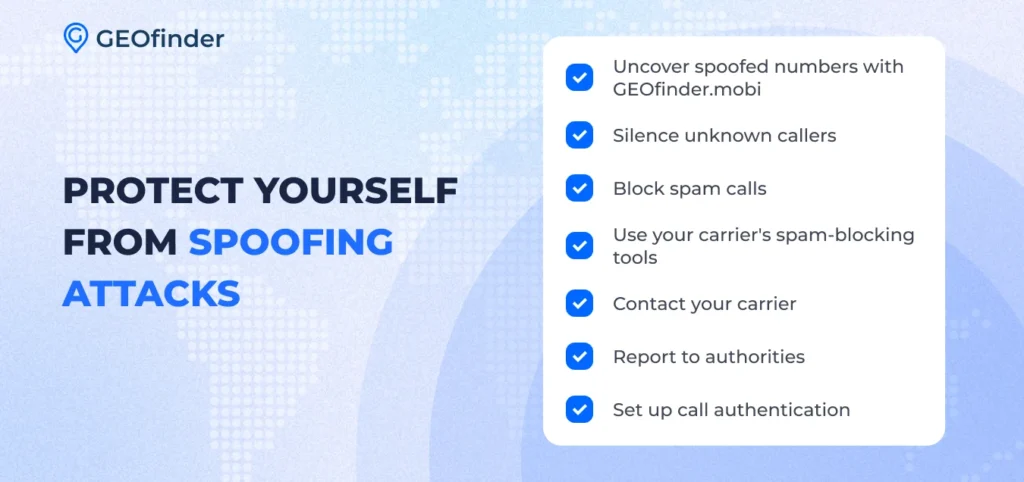
Keep yourself safe and stay one step ahead – check out these tips to shield yourself from fraudsters trying to mess with your peace of mind.
- Use the GEOfinder.mobi reverse phone lookup
When a number you’re unfamiliar with pops up, don’t jump to answer right away. With GEOfinder, you can quickly look up who’s really calling you. This tool helps you determine if it’s a scammer or someone you should talk to.
- Silence unknown callers on Android & iPhone
On both Android and iPhone, you can easily silence calls from unrecognized numbers and let them go straight to voicemail. You might miss a call or two, but you’ll save yourself from spam.
- iPhone: Go to Settings, tap Phone, and flip on Silence Unknown Callers.
- Android: Open the Phone app, hit the three dots, then go to Spam and Call Screen, and switch on See Caller & Spam ID.
- Block spam numbers
Getting harassed by the same scammer over and over? Block them! If you don’t want to deal with repeat offenders, blocking those numbers from your call log is easy.
- iPhone: Tap the More Info button, scroll down, and hit Block this Caller.
- Android: Press and hold the number you want to block, then tap Block.
- Use your carrier’s spam-blocking apps
Phone companies are catching on to spam, too. They offer apps that can block unwanted calls and even alert you when a scammer tries to get through.
- How to stop someone from spoofing my number
If someone’s using your number to scam others, it’s not just a nuisance – it can be dangerous. Here’s what you can do:
- Contact your carrier immediately to let them know your number’s been spoofed. They can help protect you from further misuse.
- Report the issue to the authorities. If a scammer’s using your number, they can be held accountable.
- Set up call authentication with your carrier to protect your number from being spoofed.
By following these steps, you’ll be armed and ready to tackle spoofing attacks before they even get to you. A little prevention goes a long way in keeping those scammers at bay!
To Sum Up
Spam calls are more than just a nuisance – they’re dangerous. With spoofed numbers, you’re completely blind to who’s on the other end, which makes it tricky to spot a scam. That’s why it’s important to know how to tell if a phone number is spoofed and be prepared for anything. How to know if a phone number is fake? Tools like GEOfinder.mobi can help you in no time, giving you the power to uncover who’s really calling. Don’t forget to contact your carrier to let them know what’s happening. Being proactive will help you stay safe and avoid any nasty surprises!


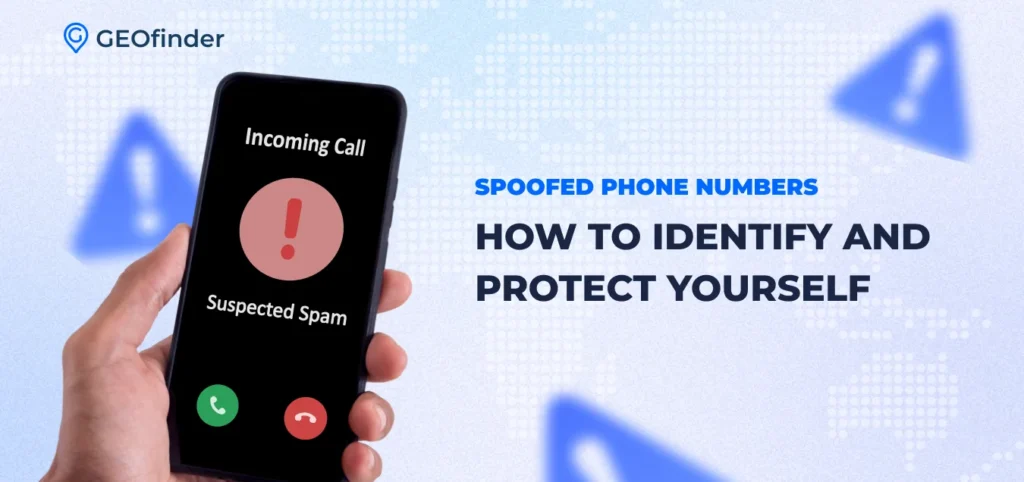
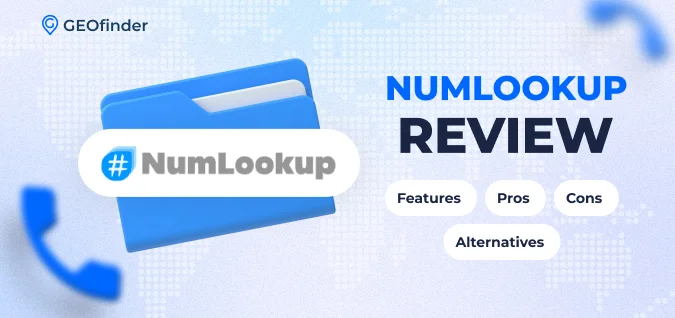
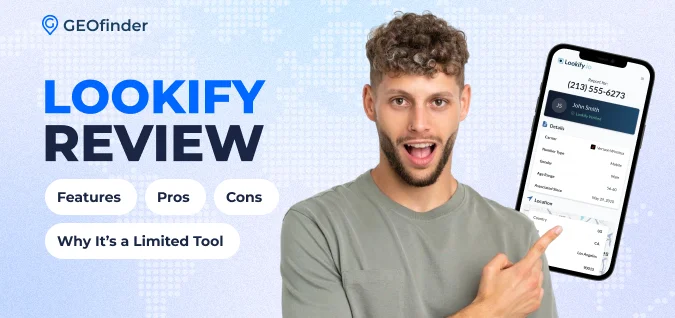
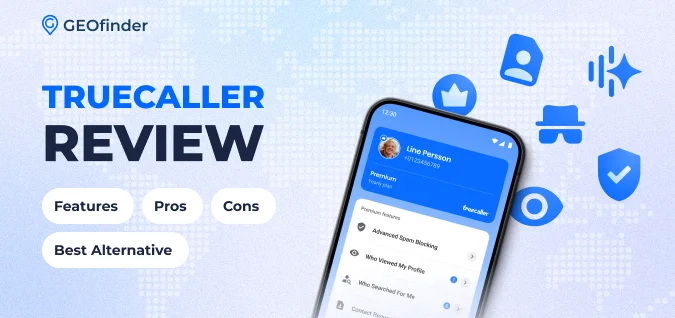
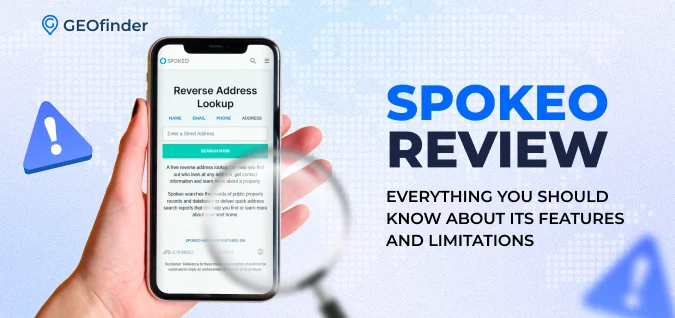

Comments